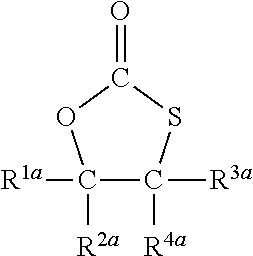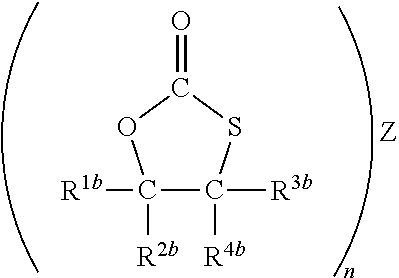Process for the purification of organic sulfur compounds
a technology of organic sulfur compounds and purification methods, applied in the purification/separation/stabilisation of organic compounds, organic chemistry, chemistry apparatuses and processes, etc., can solve the problems of unreported purification or reduction of odor in prior art, unpleasant or unpleasant smell of monothiocarbonates obtained, and bad odor of organic sulfur compounds obtained
- Summary
- Abstract
- Description
- Claims
- Application Information
AI Technical Summary
Benefits of technology
Problems solved by technology
Method used
Image
Examples
examples
Synthesis of 5-[4-[(2-oxo-1,3-oxathiolan-5-yl)methoxy]butoxymethyl]-1,3-oxathiolan-2-one of Formula
[0070]
which is shortly referred to as butanediol-dithiocarbonate or BDO-TC.
[0071]The synthesis was made according to the process disclosed in WO 2019 / 034469 A1.
[0072]In the first step of the synthesis, the epoxide 1,4 butanediol diglycidylether was reacted with phosgene as described in WO 2019 / 034469 A1.
[0073]In the second step, the obtained β-chloroalkyl chloroformiate ([2-chloro-1-[4-(3-chloro-2-chlorocarbonyloxy-propoxy)butoxymethyl]ethyl] carbonochloridate) (845 g, 2.1 mol) and dichloromethane (2.5 L) were placed in a 8 liter reactor. The solution was cooled down to 0° C. before Na2S (2.2 eq., 15 wt % aqueous solution) was slowly added, maintaining the temperature at 5° C. After the complete addition the reaction mixture was allowed to warm to room temperature and stirred for 1 hour. The phases were separated, and the aqueous phase was extracted with dichloromethane (1×0.5 L). The ...
examples 1 to 13
Purification Examples 1 to 13
[0080]The respective BDO-TC (5 g) was dissolved in toluene (10 g), and the additive (see table) was added in an amount of 5 parts by weight, based on 100 parts by weight of the solution. The temperature was at 25° C. The solution was stirred for 2 hours before the additive was filtered off. All volatiles and toluene were removed from the organic phase under reduced pressure, yielding the BDO-TC as a viscous liquid.
Testing
[0081]The odor of the BDO-TC obtained was tested immediately thereafter. The samples were tested at room temperature by 3 different people. The participants reported their olfactoral assessment according to the following classification scheme:
[0082]The odor was judged pursuant to a scale from 1 to 5.
1: odorless
2: slight stale odor
3: slight “mercaptan odor”
4: “mercaptan odor”
5: distinct “mercaptan odor”
[0083]Before the treatment with the additive, the pure BDO-TC had an odor of classification 4
[0084]Before the treatment with the additive,...
PUM
| Property | Measurement | Unit |
|---|---|---|
| temperature | aaaaa | aaaaa |
| temperature | aaaaa | aaaaa |
| temperature | aaaaa | aaaaa |
Abstract
Description
Claims
Application Information
 Login to View More
Login to View More - R&D
- Intellectual Property
- Life Sciences
- Materials
- Tech Scout
- Unparalleled Data Quality
- Higher Quality Content
- 60% Fewer Hallucinations
Browse by: Latest US Patents, China's latest patents, Technical Efficacy Thesaurus, Application Domain, Technology Topic, Popular Technical Reports.
© 2025 PatSnap. All rights reserved.Legal|Privacy policy|Modern Slavery Act Transparency Statement|Sitemap|About US| Contact US: help@patsnap.com



